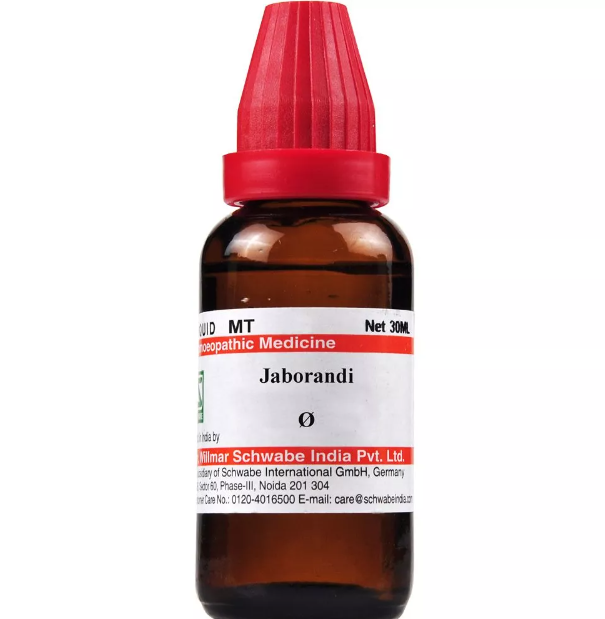JABORANDI Q, 6C, 12C, 30C, 200C, 1M, 10M USES AND SYMPTOMS
 Jaborandi
Jaborandi
Jab.
Jaborandi is a potent glandular stimulant and effective diaphoretic. It primarily induces diaphoresis, salivation, and myosis. It causes hot flushes, nausea, salivation, and heavy sweating. Minutes after ingestion, the face, ears, and neck turn deeply flushed, and the body perspires profusely while saliva flows almost continuously. Other secretions like lachrymal, nasal, bronchial, and intestinal are also affected, though less intensely. A single dose can produce up to half a pint of sweat and saliva.
Jaborandi is effective against abnormal sweating, notably in night sweats of phthisis, and may act on the thyroid. It’s useful for exophthalmic goitre, with symptoms like increased heart action, arterial pulsations, tremors, nervousness, heat, sweating, and bronchial irritation. It’s also valuable in limiting mumps duration.
Eyes: Effective for eye strain, ciliary muscle irritability, aesthenopia, heat, and burning eyes. It helps with headaches, smarting, pain in the globe, glaucoma, hazy vision, and retinal image retention. It also addresses irritation from artificial light, pupil contraction, staring, myopia, vertigo, nausea, white spots, smarting pain, twitching lids, atrophic choroiditis, and reading-induced accommodation spasm.
Ears: Serous exudation in tympanitic cavities. Tinnitus (Pilocarpinum 2x).
Mouth: Viscid saliva, dryness, free salivation (mumps), and profuse sweating.
Stomach: Nausea from moving objects, vomiting, stomach pressure, and pain.
Abdomen: Painless diarrhea during the day, with a flushed face and profuse sweat.
Urinary: Scanty urine, pain over the pubes, and frequent urging.
Respiratory: Inflamed bronchial mucous membrane, coughing, difficult respiration, lung edema (hydrothorax), foamy sputa, profuse, thin, serous expectoration, slow, sighing respiration.
Heart: Irregular, dicrotic pulse, chest oppression, cyanosis, collapse, and nervous cardiac issues.
Skin: Excessive perspiration, persistent dryness, dry eczema, semi-lateral sweats, and chilliness with sweat.
Relationship: Compare with Aml-ns., Atrop., Phys., Lyc., Ruta, Pilocarpinum muriaticum (Meniere’s disease, progressive phthisis with free hemorrhages, profuse sweating, 2x trituration). Atropinum antagonizes Pilocarpinum, in a dose of one one-hundredth grain for one-sixth of Pilocarpinum.
Non-homeopathic Uses: Mainly as a powerful, rapid diaphoretic, beneficial in renal disease with uremia, eliminating water and urea, treating scarlatinal dropsy. Contraindicated in heart failure, post-puerperal uremia, and senile cases. Dose: One-eighth to one-fourth grain hypodermically.
SYMPTOMS OF JABORANDI
Eyes:
Eye strain
Ciliary muscle irritability (ciliary spasm)
Eyes tire easily (aesthenopia)
Heat and burning in the eyes
Headache and pain in the eye globe
Blurry distance vision (glaucoma)
Retained retinal images
Irritation from artificial light
Contracted pupils unresponsive to light
Near-sightedness (myopia)
Vertigo and nausea after using eyes
White spots before the eyes
Smarting pain in the eyes
Twitching eyelids
Atrophic choroiditis
Spasm of accommodation while reading
Ears:
Serous exudation into the tympanic cavities
Tinnitus
Mouth:
Viscid, egg-white-like saliva
Dryness
Free salivation, especially in mumps
Profuse sweating
Stomach:
Nausea from looking at moving objects
Vomiting
Stomach pressure and pain
Abdomen:
Painless diarrhea
Flushed face and profuse sweat during the day
Urinary:
Scanty urine
Pain over the pubes with frequent urging
Respiratory:
Inflamed bronchial mucous membrane (bronchitis)
Inclination to cough with difficult breathing
Lung edema (hydrothorax)
Foamy sputum
Profuse, thin, serous expectoration
Slow, sighing respiration
Heart:
Irregular, dicrotic pulse
Chest oppression
Cyanosis
Collapse
Nervous cardiac affections
Skin:
Excessive sweating
Persistent skin dryness
Dry eczema
Semi-lateral sweats
Chilliness with sweat
Non-homeopathic Uses:
Powerful, rapid diaphoretic
Useful in renal disease, especially with uremia
Eliminates water and urea
Treats scarlatinal dropsy
Contraindicated in heart failure, post-puerperal uremia, and senile cases
selection of the potency
Individualization:
- Homeopathy is based on the principle of treating the individual, not just the disease. The unique symptoms and characteristics of the person are crucial in determining the most suitable potency.
Intensity of Symptoms:
- The intensity of the symptoms guides the choice of potency. If the symptoms are intense and acute, a lower potency (e.g., 6C, 30C) might be considered. For chronic conditions with less intensity, higher potencies (e.g., 200C, 1M) may be appropriate.
Sensitivity of the Patient:
- Some individuals are more sensitive to homeopathic remedies, while others may require higher potencies. The practitioner considers the patient’s sensitivity when selecting the potency.
Acute vs. Chronic Conditions:
- Lower potencies are often used for acute conditions, while higher potencies may be considered for chronic or long-standing issues.
Previous Response to Potencies:
- The patient’s response to previous homeopathic treatments helps guide the choice of potency. If a particular potency has been effective in the past, it may be repeated or adjusted as needed.
Vital Force and Susceptibility:
- Homeopathy views illness as a disturbance in the vital force. The practitioner assesses the patient’s overall vitality and susceptibility to determine the appropriate potency.
Aggravation or Amelioration:
- The direction of the symptom response (aggravation or amelioration) after taking a remedy can influence the choice of potency.
Miasmatic Considerations:
- In classical homeopathy, the concept of miasms (inherited disease tendencies) is considered. The practitioner take this into account when selecting the potency.
Practitioner Experience:
- The experience and preference of the homeopathic practitioner play a role. Some practitioners may have success with certain potencies based on their clinical experience.
SAFETY INFORMATION
- Do not exceed the recommended dose by physician
- Keep out of the reach of children
- Store in a cool dry place away from direct sunlight
- Maintain half an hour gap between food/drink/any other medicines and homoeopathic medicine
- Avoid any strong smell in the mouth while taking medicine e.g. camphor, garlic, onion, coffee, hing
Medicine images use for reference only selection of homeopathic medicine depends on the individual’s specific symptoms and overall constitution. Moreover, homeopathy is a holistic system of medicine that treats the individual as a whole. In addition to addressing the physical symptoms, it takes into account the emotional and mental state of the person. Consequently, it’s crucial to consult with a qualified homeopathic practitioner for personalized treatment.
The information provided on this website is intended solely for educational purposes. Always seek the advice of your physician or other qualified health provider.
